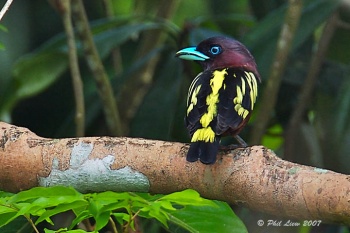Alternative names: Horsfield's Broadbill; Purple-headed Broadbill
- Eurylaimus javanicus
Identification
Size-21.5 to 23.5cm
A large, distinctive broadbill:
- Purple-red head with black lores
- Dark upperparts with prominent yellow markings
- Blackish-brown wings with broad yellow on flight feathers
- Light purple-pink underparts
- Turquoise-blue bill
- Males of most subspecies have a narrow blackish band across the beast and a greyer-tinged head than females
- javanicus has a pure yellow vent and males lack the breastband
Distribution
Found from southeast Burma to Thailand, Vietnam, Laos, Cambodia, the Malay Peninsula, Borneo, Sumatra and Java.
Locally common in suitable habitat.
Taxonomy
Subspecies
There are 5 subspecies:
- E. j. friedmanni:
- E. j. pallidus:
- Southern Thailand (Isthmus of Kra) and Malay Peninsula
- E. j. harterti:
- Sumatra, Riau Archipelago, Bangka Island and Belitung Island
- E. j. brookei:
- Borneo and North Natuna Islands
- E. j. javanicus:
- Java - should possibly be treated as full species
Habitat
Lowland forest. Broadleaved evergreen jungle, semi evergreen jungles; wetter areas in mixed decidous jungle up to 1100m, locally higher.
Behaviour
Diet
Feeds mainly on insects, takes sometimes small fruits. Plucks prey from foliage. Sits often motionless on a perch.
Breeding
They build a pear-shaped nest suspended from the branch of a large tree, usually close to the trunk. The entrance, near the top of the nest, is protected by a slanting overhang. The nest is built from twigs, and a variety of vegetable material. The exterior of the nest is covered with bryophytes, lichens and cobwebs; the interior is lined with leaves.
References
- Clements, JF. 2010. The Clements Checklist of Birds of the World. 6th ed., with updates to December 2010. Ithaca: Cornell Univ. Press. ISBN 978-0801445019. Spreadsheet available at http://www.birds.cornell.edu/clementschecklist/Clements%206.5.xls/view
- Del Hoyo, J, A Elliot, and D Christie, eds. 2003. Handbook of the Birds of the World. Volume 8: Broadbills to Tapaculos. Barcelona: Lynx Edicions. ISBN 978-8487334504
- Avibase
- Bird Ecology Study Group
- BF Member observations
Recommended Citation
- BirdForum Opus contributors. (2024) Banded Broadbill. In: BirdForum, the forum for wild birds and birding. Retrieved 12 May 2024 from https://www.birdforum.net/opus/Banded_Broadbill
External Links
GSearch checked for 2020 platform.1





